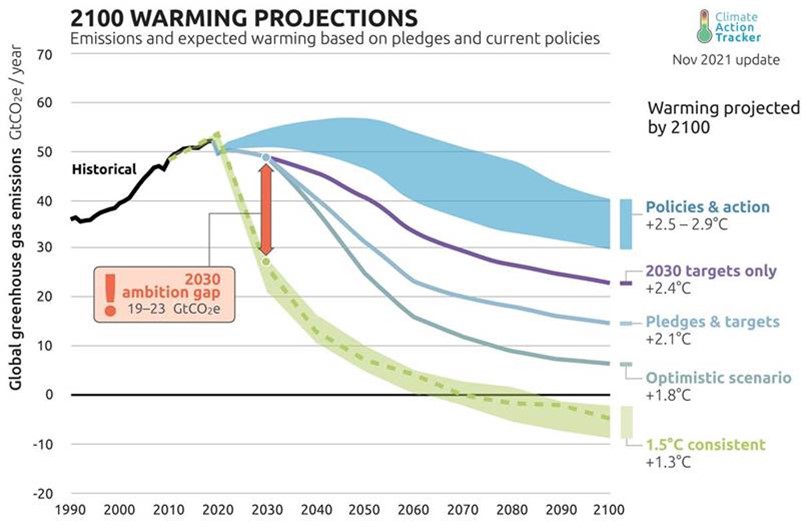Given how prominent climate change is in the governor’s agenda and rhetoric, it may be surprising to hear that Governor Inslee takes a casual approach to the issue. However, his comments before a Results Washington performance review demonstrate that his attention to the details of climate science and achieving the climate goals he says are critical is low, and that major decisions are being made with virtually no research.
After nine years in office, this was the first “Performance Review” of the state’s climate targets. It is ironic, since the state hasn’t had any climate targets in Results Washington since 2019, when they were scrubbed from the state’s web page shortly before the governor announced he was running for president.
Several things stood out in the discussion that highlight how unserious the governor’s approach to climate policy is.
“The science”
 To begin with, the governor is extremely casual with his references to “the science” of climate change. For example, he told the meeting that “statewide targets are not sufficient given the emerging science of what's going on.” This is strange because the state just recently set new targets, requiring zero CO2 emissions by 2050. I asked his spokesperson to what he was referring.
To begin with, the governor is extremely casual with his references to “the science” of climate change. For example, he told the meeting that “statewide targets are not sufficient given the emerging science of what's going on.” This is strange because the state just recently set new targets, requiring zero CO2 emissions by 2050. I asked his spokesperson to what he was referring.
The governor’s staff sent me this chart showing that if we want to keep the temperature increase to 1.5 degrees C, global emissions must be at zero by 2070. Current pledges under the Paris Climate Accords would not meet that target.
In other words, “the science” the governor was referring to is global (not statewide) and is actually less strict than Washington’s current targets. This is a clearly a poor grasp of relevant information the governor claims to follow and understand.
“Science” is not evenly divisible
Additionally, the question of what temperature target is appropriate – between 2.9 and 1.5 degrees C – is not a scientific question. It is not a coincidence that politicians have fixated on two temperature targets – 2° C and 1.5° C – that are divisible by multiples of five. No sound scientific or economic analysis is evenly divisible by five.
The purported justification for focusing on 1.5 degrees is that anything more would cause significant harm. But what does significant harm mean? They don’t say. Further, focusing a massive amount of resources on climate change instead of other priorities also does harm.
Spending on Electric Vehicle charging stations takes money away from healthcare, public safety, and money families use to live their lives and raise children. If it costs $1 billion to save one life by mitigating climate change, but we could save 10 lives by investing in safer streets, there is no “science” that says we have to spend that money on climate change, killing 10 people to save one. The claim that the 1.5 degree C target is based in “science” is just political demagoguery.
Announcing policies now, asking if they’re feasible later
Perhaps more remarkable was the discussion about the governor’s executive order mandating that all state vehicles be all-electric by 2035 (with a few exceptions for heavy duty vehicles). Any order divisible by five – 100% by 2035 – is based on politics, not analysis. But the governor made it clear during the discussion of his EV order that he had not even spoken with state agencies about whether the goal was feasible and what it would cost before he made the announcement.
At one point, the governor asked, “So do we have a, a flow chart showing what we have to achieve annually to get to the hundred percent by 2035? I mean, do we have, have we figured out what portion of our turnover have to be fully electric to get there?”
Two weeks after his announcement, it appears that this is the first time the governor is asking agencies if they have a plan for achieving the goal. Incredible.
Far from basing decisions on science or reasoned policy, it is clear the governor and his staff simply chose a date and a target based on what sounds good and announced it. Only now is he asking state agencies if his policy makes any sense.
The governor doesn’t even appear to know what it will cost simply to provide the charging infrastructure for state vehicles. When it was mentioned that it costs between $10,000 and $20,000 to install an EV charging station, the governor asked why that was the case. He noted that for his Chevy Bolt it is “just an extension cord, literally.” He said, “the system I use literally is a three prong plug into an outlet.”
Staff had to explain that many of the costs are “the electrical infrastructure, if there's not already electric coming in conduits laid under the pavement it to where you need it to be.” Hence, the need to spend tens of thousands of dollars per EV charging station.
Bravado. Failure. Blame. Repeat.
The governor’s campaign page still refers to him as the “greenest governor in the country,” and yet after nine years in office and weeks after an executive order requiring the state fleet to be 100% electric, he still seems to lack a basic understanding of the infrastructure requirements and costs to electrify state vehicles. He still cannot accurately portray the basics of the CO2 targets and temperature.
After previously claiming that “he has made Washington state a leader in the fight against climate change,” the governor now admits Washington state is nowhere close to meeting its CO2 targets. He uses this belated admission to call for still more climate regulations and spending.
For those paying attention, this is a familiar pattern. The governor mindlessly – but with great bravado – sets policy based on attracting headlines with empty soundbites and then is surprised when confronted with what it takes to live up to his proclamations. Faced with failure, he blames political opponents, and starts again.
Bravado. Failure. Blame. Repeat.
Is it any wonder Washington is spending so much time and money on climate change and achieving so little?





